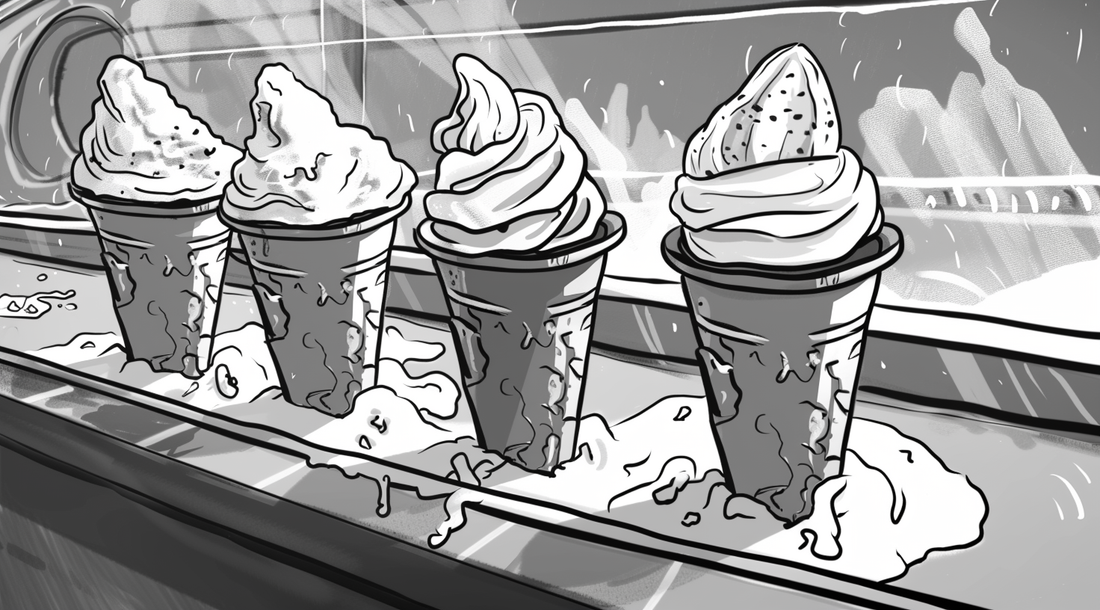If you're anything like us, hearing "let’s go get some ice cream" probably makes you weak in the knees (and strong in the waistline). Grab a napkin and get ready to catch your jaw as it drops – it's time to unveil how ice cream is made!
Too Long; Didn’t Read
- Did you know that egg yolks are a common ingredient in ice cream?!
- The ice cream process follows this order: mixing and pasteurization, aging and flavoring, freezing and churning, then hardening and packaging (and finally to your stomach of course).
- Ice cream companies are constantly innovating with new flavors and styles. Frozen custard, gelato, dippin dots… truly a revolutionary industry with a lot to offer.
- Being lactose intolerant doesn’t mean you have to give up ice cream forever!!!
Ice Cream Ingredients
There are a few main components of traditional ice cream:
Milk and Cream
Milk and cream provide the rich, velvety texture that we all crave (and the occasional lactose-induced discomfort). The internet is telling me cream can be a substitute for milk and milk can be a substitute for cream. It seems like all the best ice creams have a bit of both, though!
Sugar
Sugar isn't just there to satisfy your sweet tooth; it's a crucial component that helps lower the freezing point of the mixture, ensuring a smoother, creamier texture. Think of it as the ice cream's personal anti-freeze.
Too much sugar can make ice cream too soft and too much will make it too firm, so it’s important to measure correctly if you’re trying to make ice cream yourself!
Egg Yolks
While not mandatory, egg yolks are often the unsung heroes in premium ice cream recipes. They act as emulsifiers, helping to bind the water and fat molecules together, resulting in a smooth and rich texture. Egg yolks have a bit of an “ick” factor, so I’m sorry if this fact ruins ice cream for you.
Flavorings and Mix-Ins
From classic vanilla to adventurous combinations like mint and black raspberry, the possibilities for flavoring ice cream are endless. And let's not forget about the mix-ins – nuts, chocolate chips, cookie dough, and fruit chunks are just a few additions that can take your ice cream experience to the next level.
How Ice Cream is Made
Now that we've covered the key ingredients, it's time to dive into the process of transforming these simple components into the frozen treat we know and love.
Mixing and Pasteurization
The journey begins with the milk, cream, sugar, and any additional ingredients being combined in a large vat or mixer and pasteurized. This process involves heating the liquid to a specific temperature to kill any harmful bacteria or pathogens.
Aging and Flavoring
The mixture is cooled and aged, allowing the proteins and fats to properly hydrate and the flavors to meld together. During this stage, flavorings like vanilla extract or fruit purees are added, infusing the base with their distinctive aromas and tastes.
Freezing and Churning
The cooled mixture is poured into a specialized ice cream maker, where a dasher or blade continuously scrapes and incorporates air into the mixture as it freezes. This process, known as overrun, is what gives ice cream its signature light and airy texture.
As the mixture freezes and churns, ice crystals begin to form, but the continuous agitation prevents them from becoming too large, ensuring a smooth and creamy consistency. The churning process also incorporates air pockets, creating the desired overrun and contributing to the overall texture and mouthfeel (I can’t believe I just used that word) of the ice cream.
Hardening and Packaging
After hardening for a bit, the ice cream is ready for packaging and distribution. Many commercial ice cream makers use specialized machines to fill cartons or tubs with the frozen treat, while artisanal producers may opt for hand-packing their creations.
Variations and Innovations
While the basic process of ice cream making remains the same, there are countless variations and innovations that keep this frozen delight exciting and ever-evolving.
Custard-Based Ice Cream
Some premium ice cream varieties, like French-style or custard-based ice creams, involve cooking a portion of the mixture into a custard before blending it with the remaining ingredients. This process results in an exceptionally rich and velvety texture, often referred to as "French custard" or "French-style" ice cream.
Artisanal and Small-Batch Production
While large-scale commercial production dominates the ice cream industry, there has been a resurgence of artisanal and small-batch ice cream makers. These passionate creators often use locally sourced, high-quality ingredients and innovative flavor combinations, offering a unique and crafted experience for ice cream enthusiasts.
Our Shameless Plug
We are constantly receiving website reviews, DMs, and texts of happy customers telling us they can finally enjoy dairy again with no issues!! Here are two customers who were thrilled to have their frozen treats ;)
“[I] drank an entire milkshake on ONE pill - not a single ounce of regret! Mind you a milkshake would have me in the fetal position gassing out every person in my house for hours on end.”
“I was trying other lactose pills but always getting super bloated but with these amazing pills I have a pint of ice cream sometimes. My weight is not happy, but I am!”
If you’re lactose intolerant and ready to start enjoying ice cream again, join The Herd today.
Final Thoughts
No matter the variation or innovation, one thing remains constant: the joy and delight that a scoop of ice cream can bring. From the simplest vanilla to the most decadent and inventive flavors, the art of ice cream making is a testament to human ingenuity and our never-ending pursuit of sweet indulgence (and probably a few extra calories, but hey, you only live once!).

